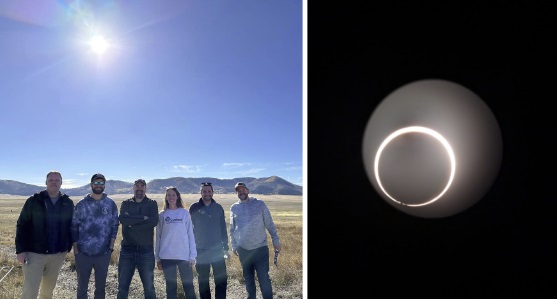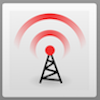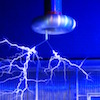Friday Flyer - October 27, 2023

Spotlight on the Colorado State University QuarkNet Center
This year has been a busy one for the CSU center. In March, they hosted a MINERvA masterclass with more than 60 high school students participating. (See the Just for Fun section to see how that day ended!) For the 2023 workshop, the teachers headed to Los Alamos, NM armed with eclipse glasses, two telescopes (including filters), and a cosmic ray detector in order to take measurements and to view the annular eclipse on October 14. (Check out their interesting preliminary flux measurements from beginning to end of the eclipse. Note that these results are preliminary, and were different than the group expected based on previous cosmic ray measurements during solar eclipses.) Several other folks viewing the eclipse stopped by to check out the equipment and stuck around for conversations about eclipses, cosmic rays, and science in general. That afternoon, the group met up with four physicists from the area for informal discussions and Q&A, including a pair of physicists many QuarkNetters know: Dan Karmgard and Danielle McDermott, mentor of the Virtual QuarkNet center. The following Monday, the group topped off their field trip with a tour of LANSCE and the High Magnetic Field Lab at Los Alamos National Laboratory. In addition to the exciting events planned during this year's workshop/field trip, the extensive "van time" provided opportunities for the group to bond, share ideas, and to discuss all sorts of topics . . . including a heated debate on the behavior of a modified modified Atwood's machine.
The group isn't done yet for the year...Many of the CSU QuarkNet teachers are leaders within the Colorado/Wyoming section of AAPT. On November 4, members of the group will be presenting at the section meeting that includes a session called QuarkNet: Bringing 21st Century Physics into the Classroom.


News from QuarkNet Central
AAPT Winter Meeting 2024: This meeting will take place in New Orleans on January 6-9. At this point, early bird registration pricing ends on November 2. Several QuarkNetters will be at this conference presenting in sessions like 21st Century Physics in the Classroom and Cosmic Ray Studies in the Classroom.
Mostly for mentors and/or lead teachers: If you have not done so already, please submit your Annual Reports and invoices for the fiscal year that just ended on August 31. Sooner is better! Not sure what to do? Check out these instructions or ask the staff!
Mark your calendar for upcoming events:
- World Wide Data Day (W2D2) is coming up on November 9. A series of memos keeps everyone updated with the latest information; the most recent (Memo #3) was just released today. Registration is open and runs until November 1. Get your students involved in this easy but captivating LHC measurement that they can do from your school in two hours or less, soup-to-nuts!
- Dark Matter Day is on or around October 31 with both virtual and in-person events all over the world. Don't let it go undetected at your school!
- International Cosmic Day is on November 21. If you have a detector, do an experiment to submit! If not, use ICD-provided online data or data from the QuarkNet Cosmic Ray e-Lab.
- Dates for International Masterclasses (IMC) 2024 have been announced in this IMC 2024 circular. (Note the DD.MM.YYYY format used for the dates.) The latest circular, hot off the virtual press, describes the registration process for IMC 2024.
Reminder: periodically check the QuarkNet Calendar for what's coming up in QuarkNet. When logged in, go to COMMUNITY > EVENTS to find this calendar. As we improve the calendar, you will see more information about not only coming events but applications, due dates, etc.

Physics Experiment Roundup
From Live Science: The world's smallest particle accelerator. And now news from an accelerator 54 million times bigger: At the LHC, a high-precision measurement of the strong force. More from CERN: For the last several weeks, the LHC has been delivering lead-ion beams to the experiments. This heavy-ion run is scheduled to end on October 30. Join CERN live from the CERN Control Center on November 2 at 3 PM CET (10 AM ET, 7 AM PT) where experts will answer questions about heavy-ion physics and the data collected during this run.
We mentioned above that Dark Matter Day (or season, really) is upon us. Learn about the LZ Dark Matter Experiment, located at the Sanford Underground Research Facility in South Dakota.
News from LIGO: Researchers report a significant advance in a technology known as quantum squeezing.

Resources
Our resources begin with a video from Don Lincoln demystifying the Heisenberg Uncertainty Principle. From Symmetry..."Spacetime: All the Universe's a Stage" and a new map of space.
Fraser Cain talks with researcher Nicholas Hunt-Smith on the question, "Can Dark Matter Be Explained by Dark Photons?" Phys.org highlights a recent paper that suggests that pulsars may be the key to finding dark matter.
The November 2023 issue of The Physics Teacher is out, and includes articles like, "Can 1 kg of Iron Float on Water?", "Where is Half of the Universe?", and "Reading the Physics in a Graph," plus many others.

Just for Fun
Since CSU was featured in the Spotlight above, we bring back a Just for Fun from the archives:
After a busy day learning about particle accelerators, detectors, and analyzing neutrino interaction data, students who participated in the 2023 MINERvA Masterclass at CSU in Fort Collins got a chance get outside and play with a different type of "particle accelerator." These Squishmallow Cannons use air to accelerate the soft and cuddly stuffed toys, and on this day were used in a competition to see which participating school could get their Squishmallow across the field first.
We end with a couple of seasonal items...
Looking for physics-themed Halloween costumes? The folks at Symmetry have a few ideas.
And finally, a record-setting pumpkin: Recently, a Minnesota educator beat his own record for growing the world's largest pumpkin. Guess how big? OK...let's make this a multiple choice quiz. (After all, nothing quite says "fun" like a quiz!)
What is the weight (in pounds) of the pumpkin that currently holds the record for largest pumpkin in the world?
a) 2.749 pounds (Hint: It's not this one.)
b) 27.49 pounds
c) 274.9 pounds
d) 2749 pounds
e) 27490 pounds (Hint: Folks, let's be reasonable!)
Please grade your own...here is the answer key.

QuarkNet Staff
Mark Adams: adams@fnal.gov
Ken Cecire: kcecire@nd.edu
Spencer Pasero: spasero@fnal.gov
Shane Wood: swood5@nd.edu
